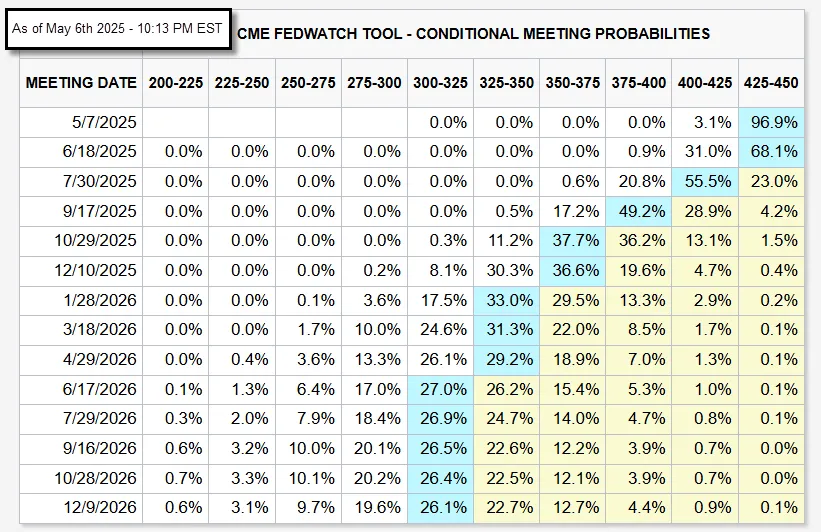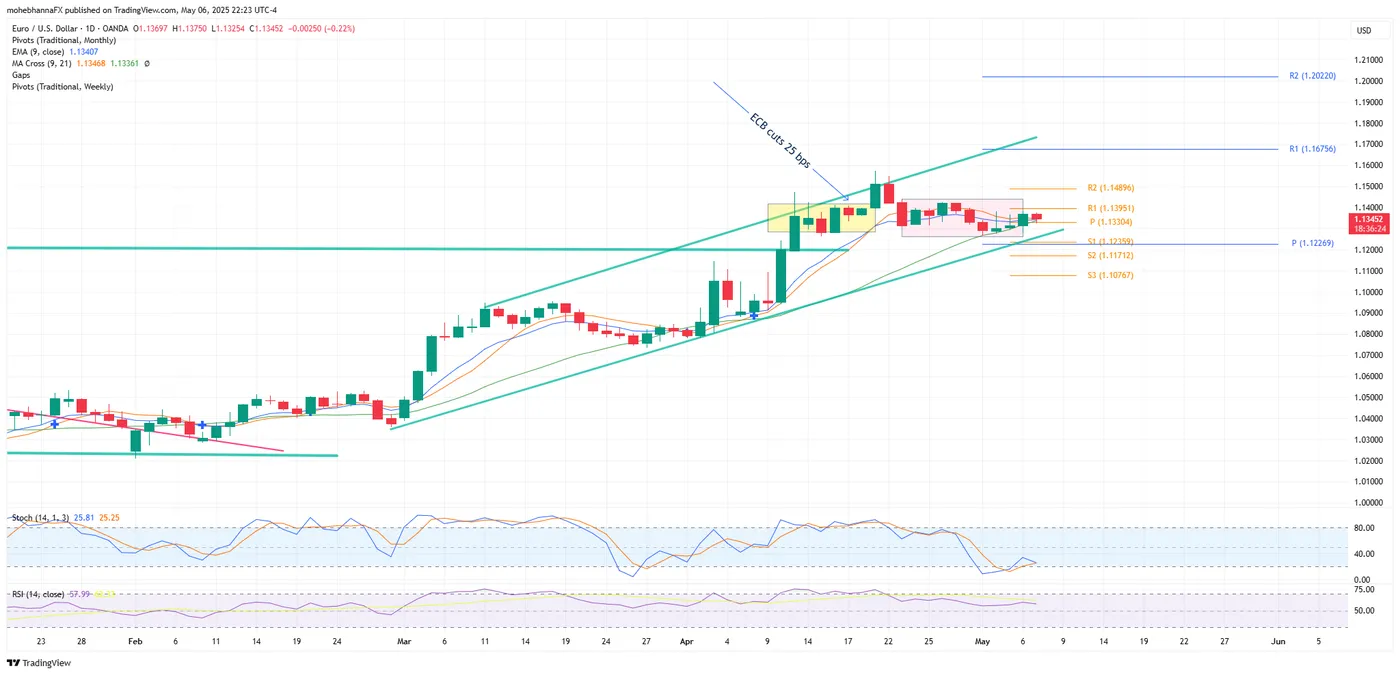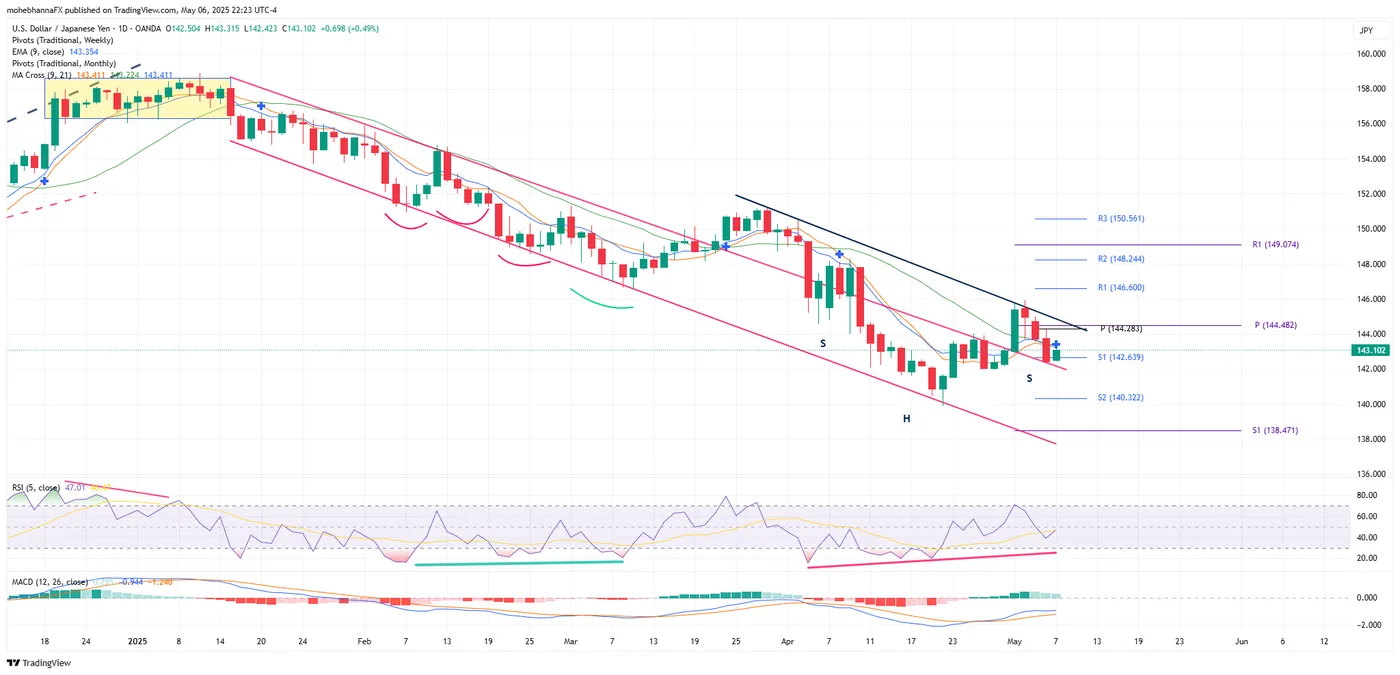Palantir launches Chain Reaction AI infrastructure platform with CenterPoint and NVIDIA
How are Economic Data and Inflation Shaping the Outlook?
This week, financial markets are keenly focused on the upcoming FOMC Federal Funds Rate decision, the FOMC statement, and the subsequent FOMC press conference. Significant uncertainty surrounds US interest rate projections due to the ongoing divergence between market expectations and the Federal Reserve’s outlook for the remaining part of 2025 and early 2026.
A key point of division within markets is how tariffs will influence the overall US economy. Recent data revealed a slowdown in US GDP for the first quarter of 2025, largely attributed to a surge in imports driven by tariff front-running. Conversely, the US job market has shown strength, and inflation, measured by the Core PCE, the FED’s preferred inflation gauge, has been slightly lower.
Specifically, the US nonfarm payroll in April exceeded forecasts, although some views suggest that the strength may not last, while the March’s Core Personal Consumption Expenditure (Core PCE) M/M dropped to 0.0% from 0.3% and the Core PCE Y/Y was 2.3% compared to 2.5%.
Market participants are split on the Federal Reserve’s potential rate cuts, with some anticipating faster cuts due to the slowing economy and low inflation, while others believe concerns about tariff-induced inflation will lead to slower cuts.
Why is Powell’s Press Conference So Important?

CME FedWatch Tool Source: https://www.cmegroup.com/markets/interest-rates/cme-fedwatch-tool.html
Past Performance is not indicative of future results.
According to the CME FedWatch tool, 97.8% of market participants expect that interest rates will remain unchanged at the upcoming May 7th, 2025 meeting. The FOMC statement is expected to acknowledge tariff concerns among policymakers, but it may not provide clear hints on future rate expectations.
The statement will be scrutinized for any significant change in language from prior statements such as “Uncertainty around the economic outlook has increased” or “Inflation remains somewhat elevated”
During the press conference, Federal Reserve Chair Jerome Powell’s remarks on the impact of tariffs will be crucial. The Fed’s Chairman may emphasize that the Federal Reserve remains data-dependent and caution that market expectations can sometimes be overly optimistic. Currently, markets anticipate more interest rate cuts than the Federal Reserve’s official forecast, with a notable difference in the number of expected basis point reductions.
EUR/USD Technical Analysis Overview
Past Performance is not indicative of future results.
- Price Action (WA:ACT) Analysis has been trading within an Ascending Channel Pattern since early March 2025. A period of Market Consolidation Zone (highlighted in yellow) occurred along the upper boundary of this channel in mid-April, coinciding with the ECB Interest Rate Impact announcement on April 17th, 2025.
- Following this Consolidation, the price initially rose but subsequently declined from 1.1500 back to the 1.1280 range. Currently, a second Consolidation period (highlighted in light red) is underway within the same price range as the previous one, emphasizing the significance of the 1.1280 to 1.1400 range for potential long-term expectations.
- Pivot Point Levels indicate that Price Action is currently trading above its monthly pivot point of 1.1226, which intersects with the lower border of the Ascending Channel Formation and weekly S1, forming a confluence of support below price.
- Moving Average Confluence is observed as Price Action trades within a narrowing range between converging fast and intermediate moving averages. These averages intersect with the weekly Pivot Point of 1.1330, creating a critical resistance level that has held since Thursday of last week, highlighting the importance of this price level.
- The Stochastic Oscillator indicator aligns with Price Action, currently in oversold territory, with the %K line crossing above the %D line.
- The Relative Strength Index (RSI) Levels also align with Price Action, although it remains near its overbought territory.
USD/JPY Technical Analysis Overview

Past Performance is not indicative of future results.
- Since early January 2025, the price trend has been confined within a descending channel. After several unsuccessful attempts, the price action successfully broke out above the channel’s upper boundary. A subsequent throwback occurred, finding support at the S1 support level of 142.63 and the broken channel line extension.
- A potential inverted head and shoulders pattern (H, S) is forming, with its neckline intersecting both the weekly pivot point and monthly pivot point, creating a significant resistance confluence between 144.28 and 144.48.
- Another nearby resistance confluence exists due to the convergence of the EMA9 (Exponential Moving Average 9), SMA9 (Simple Moving Average 9), and SMA21 (Simple Moving Average 21), which represent short-term and intermediate-term moving averages.
- A positive divergence is observed between the price action (making lower lows) and the RSI (Relative Strength Index) (making higher lows). The Stochastics indicator aligns with the price action, as its %K line has crossed above the %D line.
Conclusion
The potential strength of the US dollar hinges on how strongly Federal Reserve Chair Jerome Powell communicates a hawkish stance and suggests that markets may be overestimating future interest rate cuts. Such messaging could lead traders to reduce their expectations for rate cuts, thereby strengthening the dollar.
From a technical analysis perspective, if the inverted head and shoulders pattern on the daily chart completes, a sustained break above 144.80 could signal further gains for the US dollar against the Japanese Yen, however, should the price fail to hold above 142.30, this could indicate a renewed decline in USD/JPY, potentially pushing it back into the descending channel.
